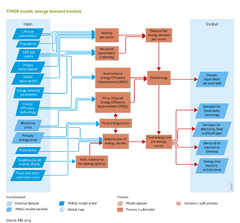Energy demand/Policy issues: Difference between revisions
Jump to navigation
Jump to search
No edit summary |
No edit summary |
||
| Line 1: | Line 1: | ||
{{ComponentPolicyIssueTemplate | {{ComponentPolicyIssueTemplate | ||
|Reference=Van den Berg et al., 2011; Van Ruijven et al., 2007; | |Reference=Van den Berg et al., 2011; Van Ruijven et al., 2007; | ||
|Description=The model shows that under a typical baseline scenario such as the one of the [[Roads from Rio+20 (2012) project|Rio+20]] study, energy demand is projected to grow significantly during the 21st century. Most growth will be driven by an increase in energy use in low-income countries. Per capita use in high-income countries is projected to remain more or less constant, consistent with recent historical trends. The increase in energy demand in the first half of the century will be mostly met by fossil fuels and electricity. In this model simulation, hydrogen becomes competitive in the transport sector in the second half of the century, as a result of increasing oil prices and the assumed progress in hydrogen technologies. An alternative assumption could result in a similar role for electricity. | |Description=The model shows that under a typical baseline scenario such as the one of the [[Roads from Rio+20 (2012) project|Rio+20]] study, energy demand is projected to grow significantly during the 21st century. Most growth will be driven by an increase in energy use in low-income countries. Per capita use in high-income countries is projected to remain more or less constant, consistent with recent historical trends. The increase in energy demand in the first half of the century will be mostly met by fossil fuels and electricity. In this model simulation, hydrogen becomes competitive in the transport sector in the second half of the century, as a result of increasing oil prices and the assumed progress in hydrogen technologies. An alternative assumption could result in a similar role for electricity. | ||
|Example=Various policy interventions can be implemented in the energy demand submodules in different ways: | |Example=Various policy interventions can be implemented in the energy demand submodules in different ways (see also the Policy interventions Table below): | ||
* Energy tax and carbon tax. This changes the prices for the energy carriers influences the choice of technology. | * Energy tax and carbon tax. This changes the prices for the energy carriers influences the choice of technology. | ||
* Discount rate/payback time. In the residential submodule , the perceived costs of capital (discount rate) influence the extent of energy efficiency improvement (PIEEI) and the choice of fuel and/or technology in the residential submodule. | * Discount rate/payback time. In the residential submodule , the perceived costs of capital (discount rate) influence the extent of energy efficiency improvement (PIEEI) and the choice of fuel and/or technology in the residential submodule. | ||
Revision as of 15:35, 22 May 2014
Parts of Energy demand/Policy issues
| Component is implemented in: |
|
| Related IMAGE components |
| Projects/Applications |
| Key publications |
| References |
